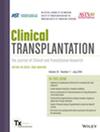Effects of Nighttime Procurement and Transplantation on Outcomes Following Heart Transplantation
Abstract
Background
This study evaluates the effects of nighttime procurement and transplantation on outcomes following heart transplantation.
Methods
The UNOS registry was queried to analyze adult recipients who underwent isolated orthotopic heart transplantation between January 1, 2010, and September 30, 2022. The cohort was stratified into daytime (4 am–8 pm) and nighttime (8 pm–4 am) transplant groups. The primary outcome was 1-year survival. Propensity score-matching was performed. Risk adjustment was performed using multivariable Cox regression. Restricted cubic spline was used to model the association between the time of transplantation and the likelihood of 1-year mortality. Sub-analysis was performed to evaluate the impact of nighttime procurement.
Results
Altogether 30 426 recipients were analyzed, where 10 807 recipients (35.5%) underwent nighttime transplantation. The nighttime recipients had reduced 1-year post-transplant survival compared to the daytime recipients (90.6% vs. 91.5%, p = 0.019), and this lower survival persisted in the propensity score-matched comparison. After adjusting for established predictors for post-transplant mortality, nighttime transplantation continued to have a significantly increased risk of 1-year mortality (hazard ratio [HR] 1.12, 95% confidence interval [CI] 1.03–1.21, p = 0.005). The spline model demonstrated increased odds of 1-year mortality between 5 pm and 4 am, with the highest odds at 11 pm (odds ratio [OR] 1.25, 95% CI 1.07–1.47), compared to the reference transplantation time of 7 am. When assessing the impact of procurement timing, nighttime procurement negatively impacted 1-year post-transplant survival among the daytime recipients.
Conclusion
This study demonstrates the adverse impact of nighttime heart procurement and transplantation on early post-transplant survival. With emerging organ perfusion and thermal protection systems, additional studies are warranted to assess the safety of extending the heart preservation period to optimize the timing of transplantation.


 求助内容:
求助内容: 应助结果提醒方式:
应助结果提醒方式:


